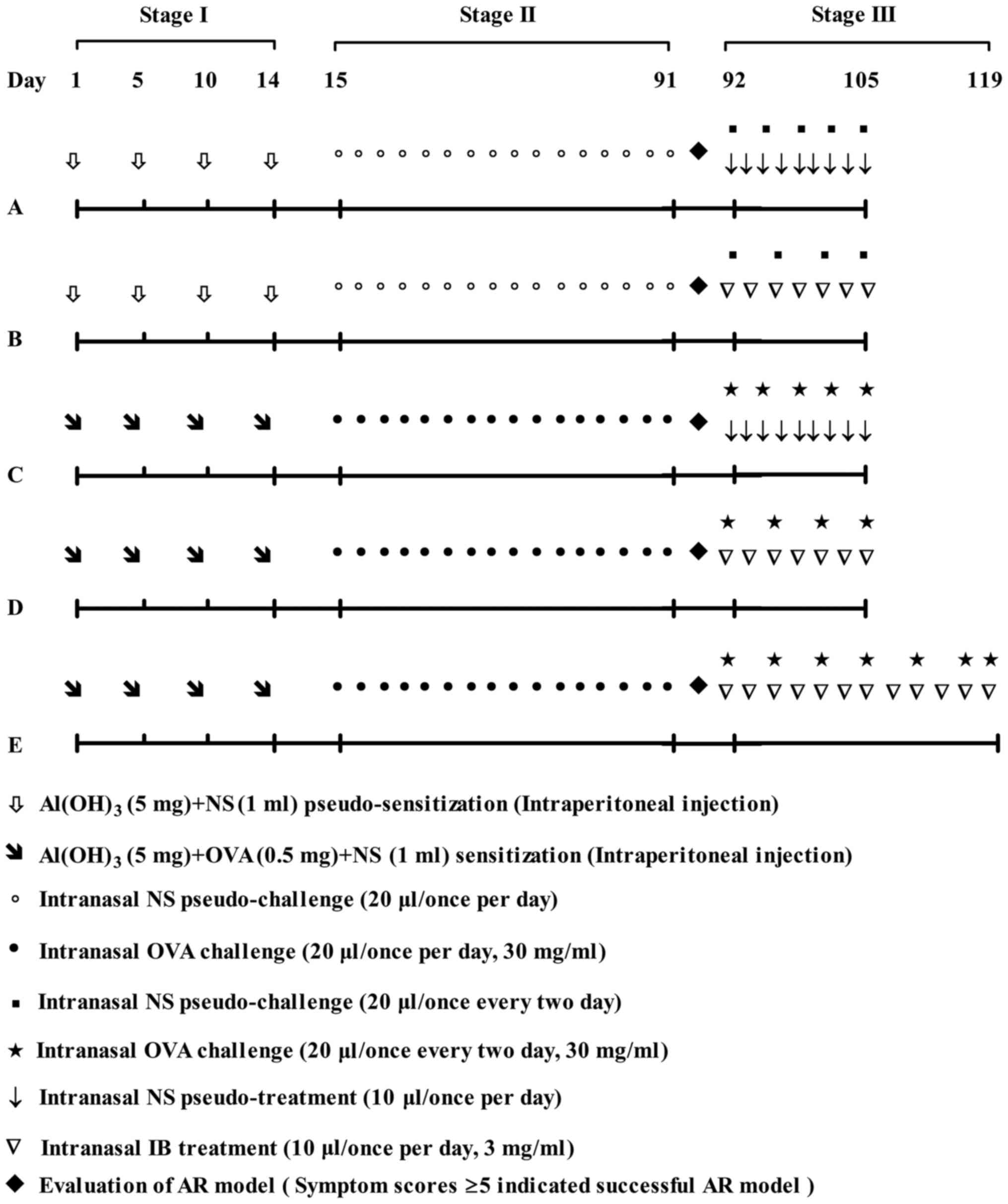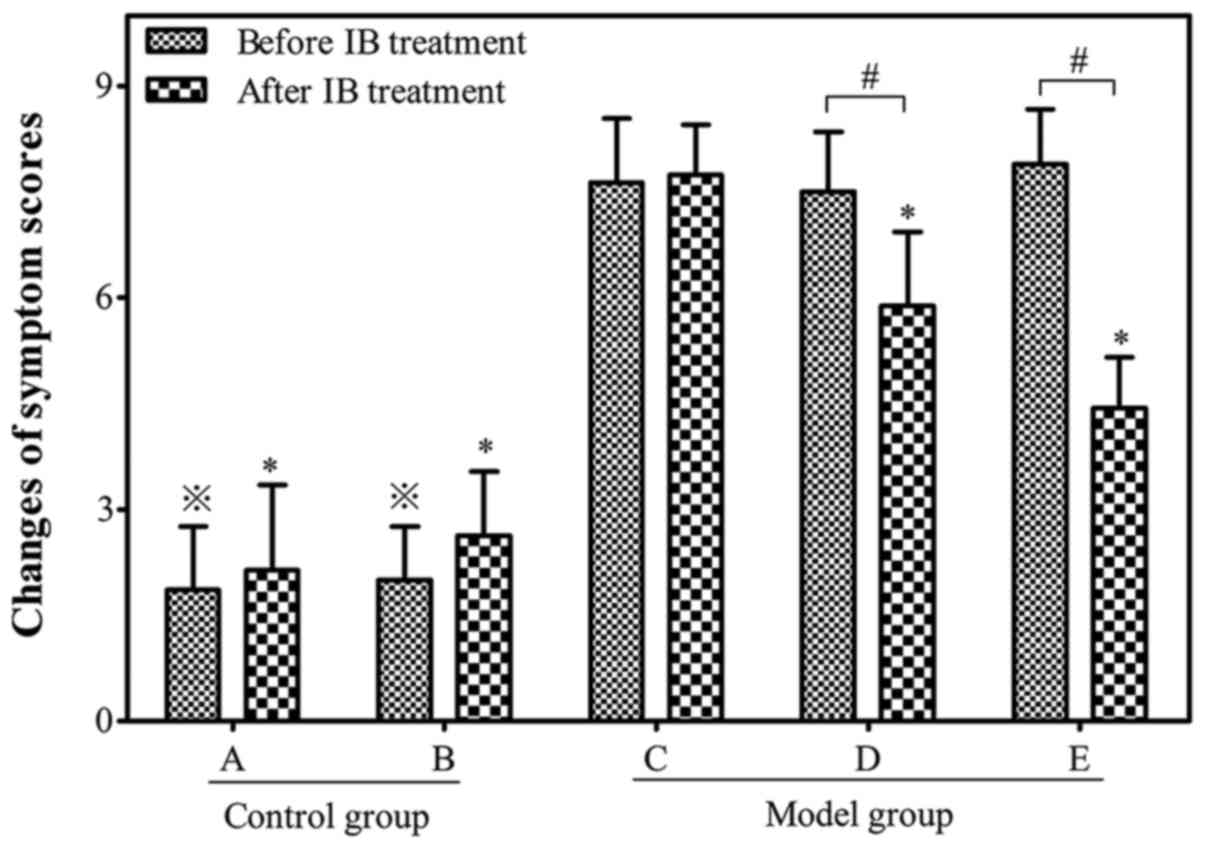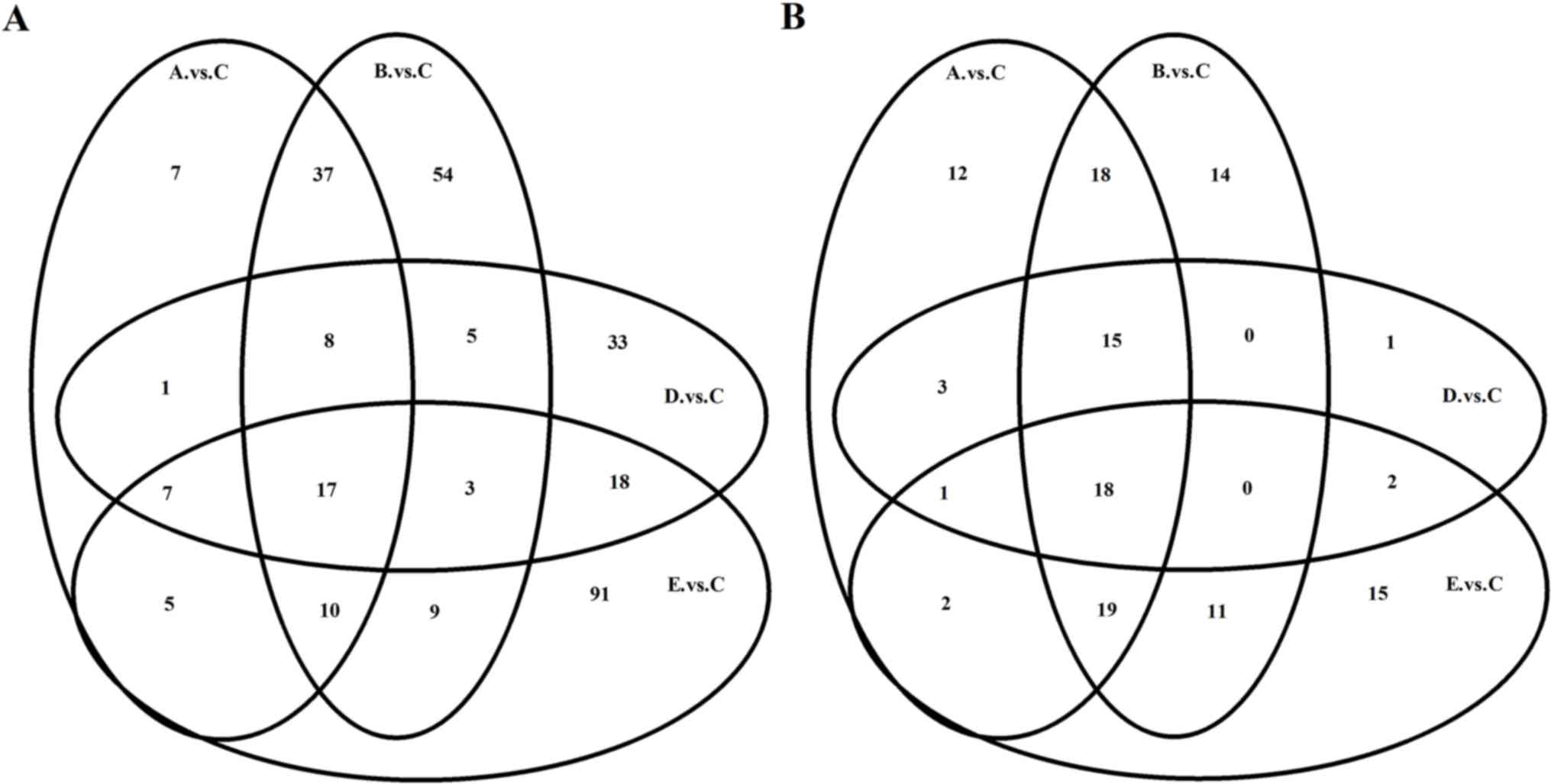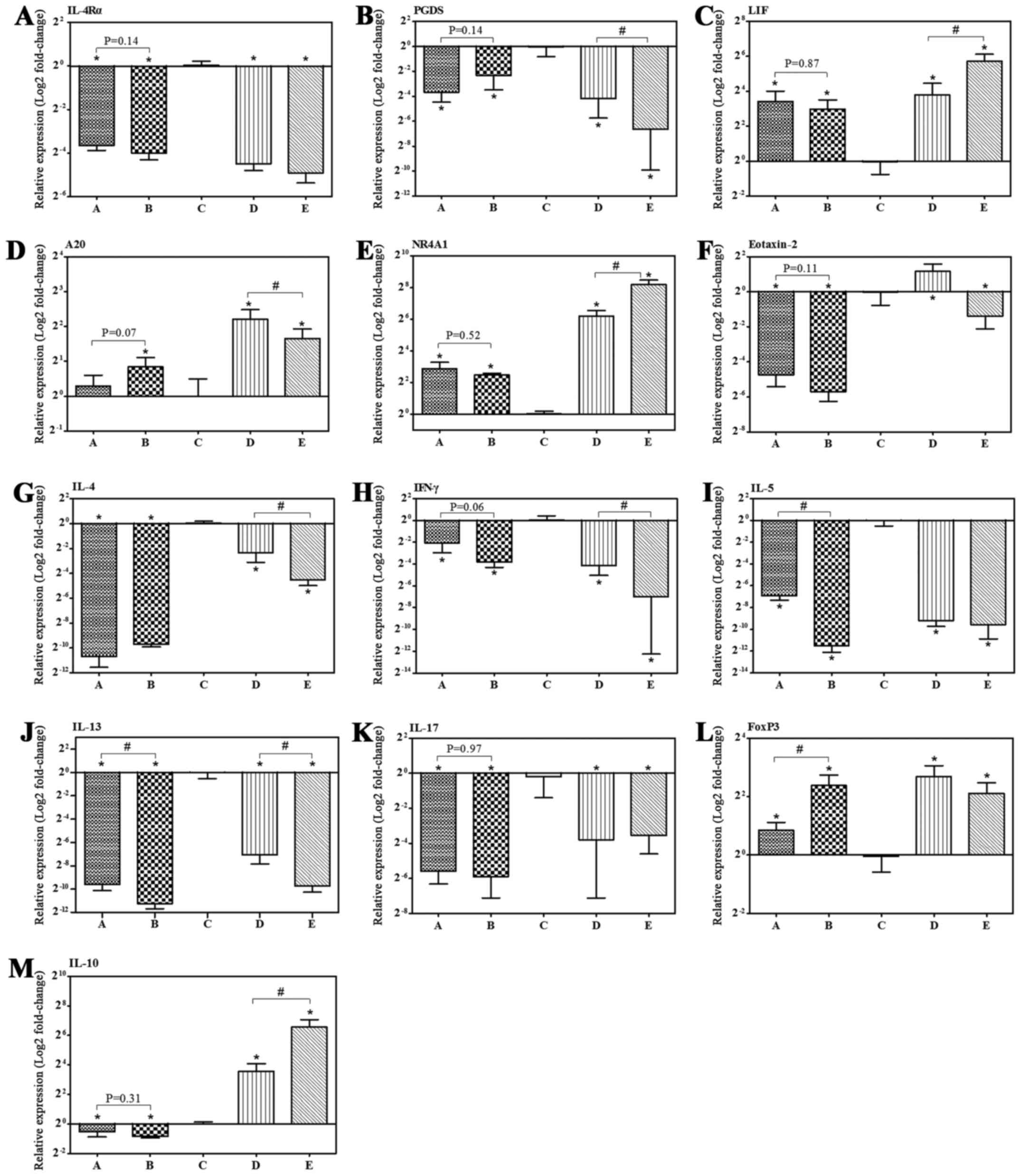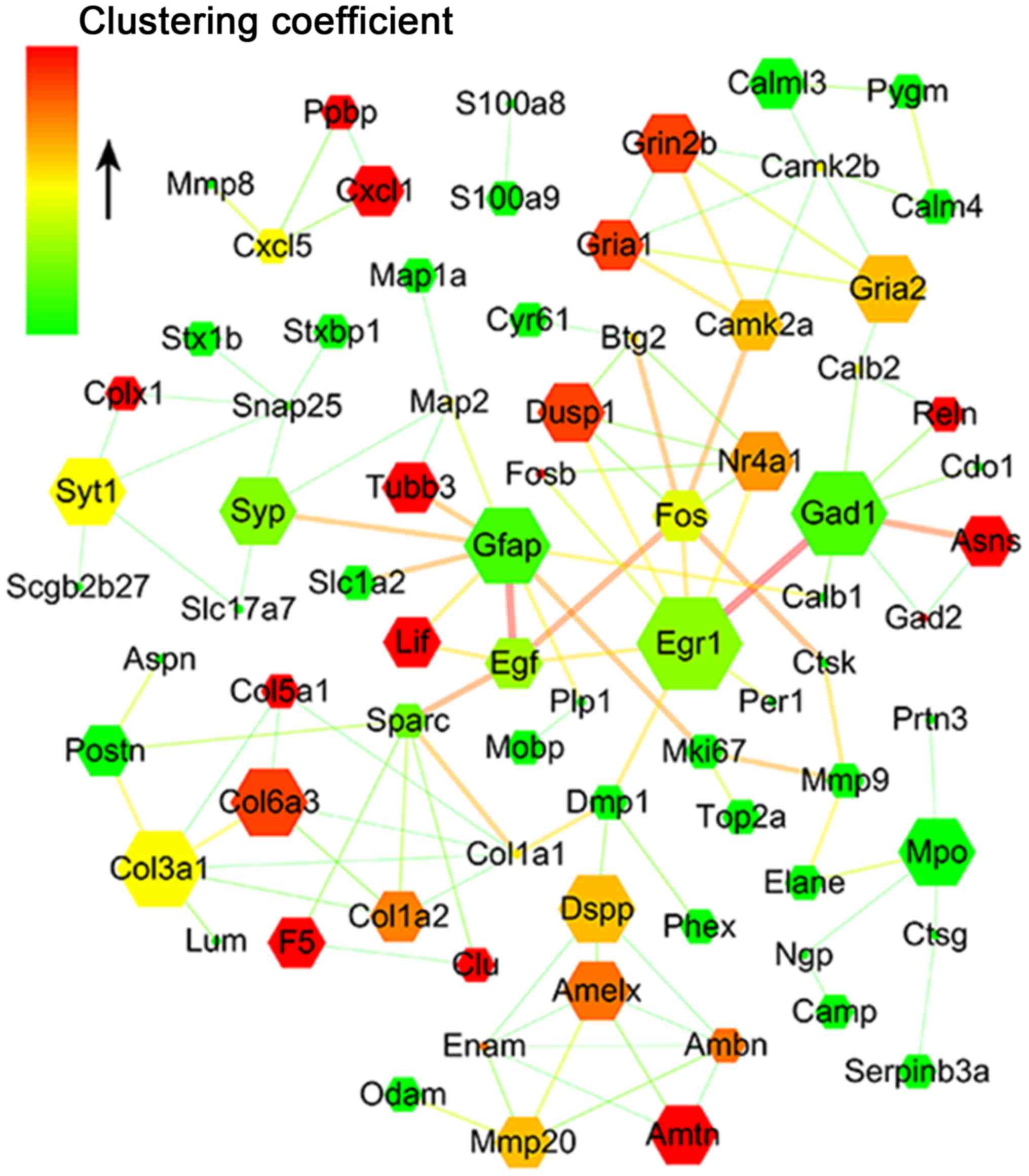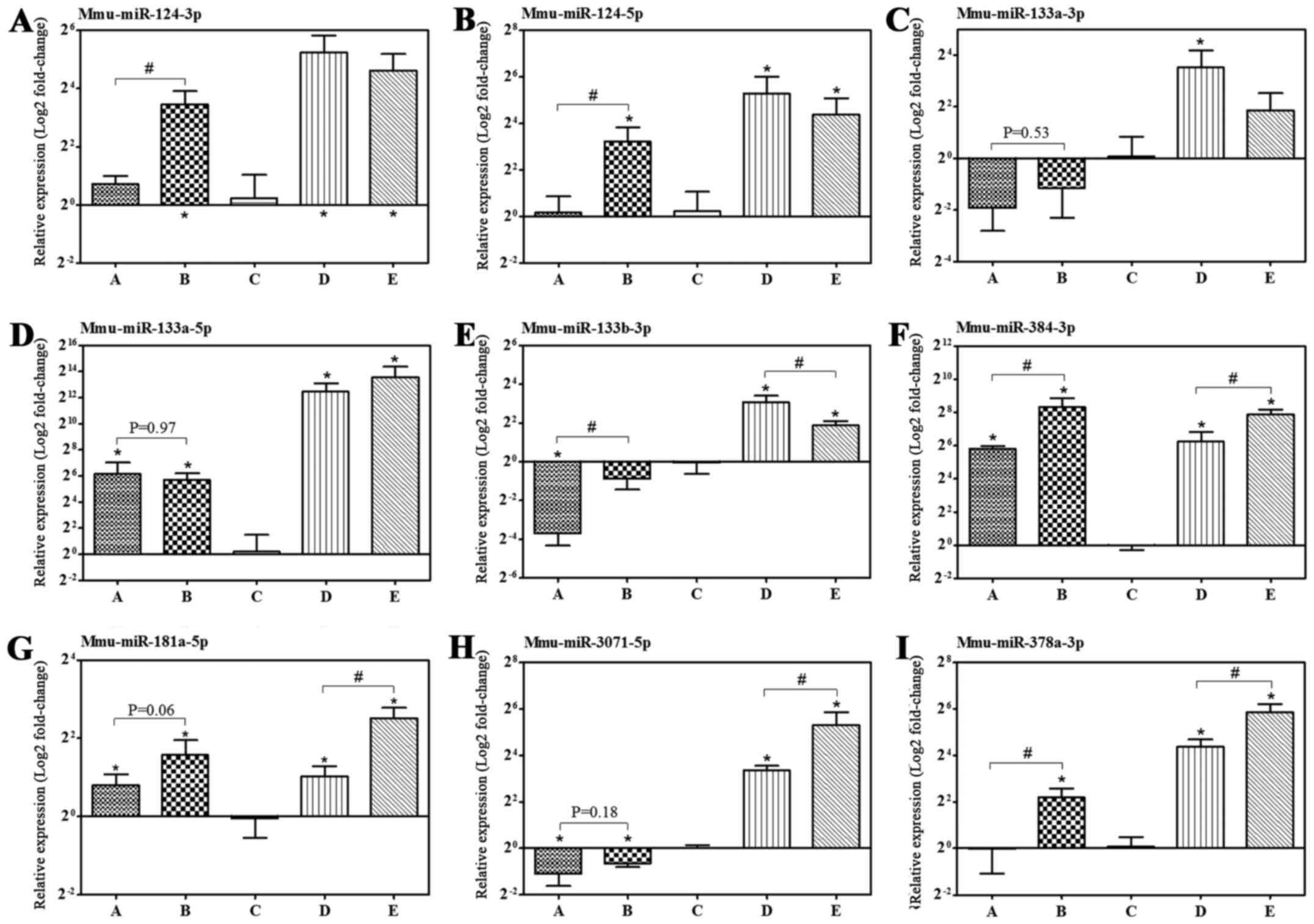|
1
|
Daoud A, Xie Z, Ma Y, Wang T and Tan G:
Changes of T-helper type 1/2 cell balance by anticholinergic
treatment in allergic mice. Ann Allergy Asthma Immunol.
112:249–255. 2014. View Article : Google Scholar : PubMed/NCBI
|
|
2
|
Teng Y, Zhang R, Liu C, Zhou L, Wang H,
Zhuang W, Huang Y and Hong Z: miR-143 inhibits
interleukin-13-induced inflammatory cytokine and mucus production
in nasal epithelial cells from allergic rhinitis patients by
targeting IL13Rα1. Biochem Biophys Res Commun. 457:58–64. 2015.
View Article : Google Scholar : PubMed/NCBI
|
|
3
|
Lu TX and Rothenberg ME: Diagnostic,
functional, and therapeutic roles of microRNA in allergic diseases.
J Allergy Clin Immunol. 132:3–14. 2013. View Article : Google Scholar : PubMed/NCBI
|
|
4
|
Ogoda M, Niiya R, Koshika T and Yamada S:
Comparative characterization of lung muscarinic receptor binding
after intratracheal administration of tiotropium, ipratropium, and
glycopyrrolate. J Pharmacol Sci. 115:374–382. 2011. View Article : Google Scholar : PubMed/NCBI
|
|
5
|
Anders S, Pyl PT and Huber W: HTSeq-a
Python framework to work with high-throughput sequencing data.
Bioinformatics. 31:166–169. 2015. View Article : Google Scholar : PubMed/NCBI
|
|
6
|
Wang L, Feng Z, Wang X and Zhang X:
DEGseq: An R package for identifying differentially expressed genes
from RNA-seq data. Bioinformatics. 26:136–138. 2010. View Article : Google Scholar : PubMed/NCBI
|
|
7
|
Shannon P, Markiel A, Ozier O, Baliga NS,
Wang JT, Ramage D, Amin N, Schwikowski B and Ideker T: Cytoscape: A
software environment for integrated models of biomolecular
interaction networks. Genome Res. 13:2498–2504. 2003. View Article : Google Scholar : PubMed/NCBI
|
|
8
|
Langmead B, Trapnell C, Pop M and Salzberg
SL: Ultrafast and memory-efficient alignment of short DNA sequences
to the human genome. Genome Biol. 10:R252009. View Article : Google Scholar : PubMed/NCBI
|
|
9
|
Griffiths-Jones S, Saini HK, van Dongen S
and Enright AJ: miRBase: Tools for microRNA genomics. Nucleic Acids
Res. 36(Database issue): D154–D158. 2008.PubMed/NCBI
|
|
10
|
Friedländer MR, Chen W, Adamidi C,
Maaskola J, Einspanier R, Knespel S and Rajewsky N: Discovering
microRNAs from deep sequencing data using miRDeep. Nat Biotechnol.
26:407–415. 2008. View
Article : Google Scholar : PubMed/NCBI
|
|
11
|
Moxon S, Schwach F, Dalmay T, Maclean D,
Studholme DJ and Moulton V: A toolkit for analysing large-scale
plant small RNA datasets. Bioinformatics. 24:2252–2253. 2008.
View Article : Google Scholar : PubMed/NCBI
|
|
12
|
Zhou L, Chen J, Li Z, Li X, Hu X, Huang Y,
Zhao X, Liang C, Wang Y, Sun L, et al: Integrated profiling of
microRNAs and mRNAs: microRNAs located on Xq27.3 associate with
clear cell renal cell carcinoma. PLoS One. 5:e152242010. View Article : Google Scholar : PubMed/NCBI
|
|
13
|
John B, Enright AJ, Aravin A, Tuschl T,
Sander C and Marks DS: Human MicroRNA targets. PLoS Biol.
2:e3632004. View Article : Google Scholar : PubMed/NCBI
|
|
14
|
Wu J, Mao X, Cai T, Luo J and Wei L: KOBAS
server: A web-based platform for automated annotation and pathway
identification. Nucleic Acids Res. 34(Web Server issue): W720–W724.
2006. View Article : Google Scholar : PubMed/NCBI
|
|
15
|
Arocho A, Chen B, Ladanyi M and Pan Q:
Validation of the 2-DeltaDeltaCt calculation as an alternate method
of data analysis for quantitative PCR of BCR-ABL P210 transcripts.
Diagn Mol Pathol. 15:56–61. 2006. View Article : Google Scholar : PubMed/NCBI
|
|
16
|
Kistemaker LE, Bos ST, Mudde WM, Hylkema
MN, Hiemstra PS, Wess J, Meurs H, Kerstjens HA and Gosens R:
Muscarinic M3 receptors contribute to allergen-induced airway
remodeling in mice. Am J Respir Cell Mol Biol. 50:690–698. 2014.
View Article : Google Scholar : PubMed/NCBI
|
|
17
|
Oeser K, Maxeiner J, Symowski C, Stassen M
and Voehringer D: T cells are the critical source of IL-4/IL-13 in
a mouse model of allergic asthma. Allergy. 70:1440–1449. 2015.
View Article : Google Scholar : PubMed/NCBI
|
|
18
|
Wei Q, Sha Y, Bhattacharya A, Fattah E
Abdel, Bonilla D, Jyothula SS, Pandit L, Hershey GK Khurana and
Eissa NT: Regulation of IL-4 receptor signaling by STUB1 in lung
inflammation. Am J Respir Crit Care Med. 189:16–29. 2014.PubMed/NCBI
|
|
19
|
Moshkovits I, Karo-Atar D, Itan M,
Reichman H, Rozenberg P, Morgenstern-Ben-Baruch N, Shik D,
Ejarque-Ortiz A, Hershko AY, Tian L, et al: CD300f associates with
IL-4 receptor α and amplifies IL-4-induced immune cell responses.
Proc Natl Acad Sci USA. 112:8708–8713. 2015; View Article : Google Scholar : PubMed/NCBI
|
|
20
|
Liang MJ, Fu QL, Jiang HY, Chen FH, Chen
D, Chen DH, Lin ZB and Xu R: Immune responses to different patterns
of exposure to ovalbumin in a mouse model of allergic rhinitis. Eur
Arch Otorhinolaryngol. 273:3783–3788. 2016. View Article : Google Scholar : PubMed/NCBI
|
|
21
|
Nussbaum JC, Van Dyken SJ, von Moltke J,
Cheng LE, Mohapatra A, Molofsky AB, Thornton EE, Krummel MF, Chawla
A, Liang HE and Locksley RM: Type 2 innate lymphoid cells control
eosinophil homeostasis. Nature. 502:245–248. 2013. View Article : Google Scholar : PubMed/NCBI
|
|
22
|
Pope SM, Brandt EB, Mishra A, Hogan SP,
Zimmermann N, Matthaei KI, Foster PS and Rothenberg ME: IL-13
induces eosinophil recruitment into the lung by an IL-5- and
eotaxin-dependent mechanism. J Allergy Clin Immunol. 108:594–601.
2001. View Article : Google Scholar : PubMed/NCBI
|
|
23
|
Zhao J, Lloyd CM and Noble A: Th17
responses in chronic allergic airway inflammation abrogate
regulatory T-cell-mediated tolerance and contribute to airway
remodeling. Mucosal Immunol. 6:335–346. 2013. View Article : Google Scholar : PubMed/NCBI
|
|
24
|
Huang X, Chen Y, Zhang F, Yang Q and Zhang
G: Peripheral Th17/Treg cell-mediated immunity imbalance in
allergic rhinitis patients. Braz J Otorhinolaryngol. 80:152–155.
2014.(In English, Portuguese). View Article : Google Scholar : PubMed/NCBI
|
|
25
|
Coomes SM, Kannan Y, Pelly VS, Entwistle
LJ, Guidi R, Perez-Lloret J, Nikolov N, Müller W and Wilson MS:
CD4+ Th2 cells are directly regulated by IL-10 during
allergic airway inflammation. Mucosal Immunol. 10:150–161. 2017.
View Article : Google Scholar : PubMed/NCBI
|
|
26
|
Janssens K, van den Haute C, Baekelandt V,
Lucas S, van Horssen J, Somers V, Van Wijmeersch B, Stinissen P,
Hendriks JJ, Slaets H and Hellings N: Leukemia inhibitory factor
tips the immune balance towards regulatory T cells in multiple
sclerosis. Brain Behav Immun. 45:180–188. 2015. View Article : Google Scholar : PubMed/NCBI
|
|
27
|
Metcalfe SM: LIF in the regulation of
T-cell fate and as a potential therapeutic. Genes Immun.
12:157–168. 2011. View Article : Google Scholar : PubMed/NCBI
|
|
28
|
Sekiya T, Kashiwagi I, Inoue N, Morita R,
Hori S, Waldmann H, Rudensky AY, Ichinose H, Metzger D, Chambon P
and Yoshimura A: The nuclear orphan receptor Nr4a2 induces Foxp3
and regulates differentiation of CD4+ T cells. Nat
Commun. 2:2692011. View Article : Google Scholar : PubMed/NCBI
|
|
29
|
Sekiya T, Kondo T, Shichita T, Morita R,
Ichinose H and Yoshimura A: Suppression of Th2 and Tfh immune
reactions by Nr4a receptors in mature T reg cells. J Exp Med.
212:1623–1640. 2015. View Article : Google Scholar : PubMed/NCBI
|
|
30
|
Fassett MS, Jiang W, D'Alise AM, Mathis D
and Benoist C: Nuclear receptor Nr4a1 modulates both regulatory
T-cell (Treg) differentiation and clonal deletion. Proc Natl Acad
Sci USA. 109:3891–3896. 2012; View Article : Google Scholar : PubMed/NCBI
|
|
31
|
Schuijs MJ, Willart MA, Vergote K, Gras D,
Deswarte K, Ege MJ, Madeira FB, Beyaert R, van Loo G, Bracher F, et
al: Farm dust and endotoxin protect against allergy through A20
induction in lung epithelial cells. Science. 349:1106–1110. 2015.
View Article : Google Scholar : PubMed/NCBI
|
|
32
|
Kang NI, Yoon HY, Lee YR, Won M, Chung MJ,
Park JW, Hur GM, Lee HK and Park BH: A20 attenuates allergic airway
inflammation in mice. J Immunol. 183:1488–1495. 2009. View Article : Google Scholar : PubMed/NCBI
|
|
33
|
Nishimura T, Kaminuma O, Saeki M, Kitamura
N, Matsuoka K, Yonekawa H, Mori A and Hiroi T: Essential
contribution of CD4+ T cells to antigen-induced nasal
hyperresponsiveness in experimental allergic rhinitis. PLoS One.
11:e01466862016. View Article : Google Scholar : PubMed/NCBI
|
|
34
|
Nabe T, Kuriyama Y, Mizutani N, Shibayama
S, Hiromoto A, Fujii M, Tanaka K and Kohno S: Inhibition of
hematopoietic prostaglandin D synthase improves allergic nasal
blockage in guinea pigs. Prostaglandins Other Lipid Mediat.
95:27–34. 2011. View Article : Google Scholar : PubMed/NCBI
|
|
35
|
Kajiwara D, Aoyagi H, Shigeno K, Togawa M,
Tanaka K, Inagaki N and Miyoshi K: Role of hematopoietic
prostaglandin D synthase in biphasic nasal obstruction in guinea
pig model of experimental allergic rhinitis. Eur J Pharmacol.
667:389–395. 2011. View Article : Google Scholar : PubMed/NCBI
|
|
36
|
Golebski K, van Egmond D, de Groot EJ,
Roschmann KI, Fokkens WJ and van Drunen CM: EGR-1 and DUSP-1 are
important negative regulators of pro-allergic responses in airway
epithelium. Mol Immunol. 65:43–50. 2015. View Article : Google Scholar : PubMed/NCBI
|
|
37
|
Luo X, Ma R, Wu X, Xian D, Li J, Mou Z and
Li H: Azelastine enhances the clinical efficacy of glucocorticoid
by modulating MKP-1 expression in allergic rhinitis. Eur Arch
Otorhinolaryngol. 272:1165–1173. 2015. View Article : Google Scholar : PubMed/NCBI
|
|
38
|
Maier JV, Brema S, Tuckermann J, Herzer U,
Klein M, Stassen M, Moorthy A and Cato AC: Dual specificity
phosphatase 1 knockout mice show enhanced susceptibility to
anaphylaxis but are sensitive to glucocorticoids. Mol Endocrinol.
21:2663–2671. 2007. View Article : Google Scholar : PubMed/NCBI
|
|
39
|
Lohoff M, Giaisi M, Köhler R, Casper B,
Krammer PH and Li-Weber M: Early growth response protein-1 (Egr-1)
is preferentially expressed in T helper type 2 (Th2) cells and is
involved in acute transcription of the Th2 cytokine interleukin-4.
J Biol Chem. 285:1643–1652. 2010. View Article : Google Scholar : PubMed/NCBI
|
|
40
|
Li B, Berman J, Wu P, Liu F, Tang JT and
Lin TJ: The early growth response factor-1 contributes to
interleukin-13 production by mast cells in response to stem cell
factor stimulation. J Immunotoxicol. 5:163–171. 2008. View Article : Google Scholar : PubMed/NCBI
|
|
41
|
Liu Z, Zhang XH, Callejas-Diaz B and
Mullol J: MicroRNA in united airway diseases. Int J Mol Sci.
17(pii): E7162016. View Article : Google Scholar : PubMed/NCBI
|
|
42
|
Sawaki H, Nakamura F, Aihara M, Nagashima
Y, Komori-Yamaguchi J, Yamashita N, Nakazawa M, Goshima Y and
Ikezawa Z: Intranasal administration of semaphorin-3A alleviates
sneezing and nasal rubbing in a murine model of allergic rhinitis.
J Pharmacol Sci. 117:34–44. 2011. View Article : Google Scholar : PubMed/NCBI
|
|
43
|
Baudet ML, Zivraj KH, Abreu-Goodger C,
Muldal A, Armisen J, Blenkiron C, Goldstein LD, Miska EA and Holt
CE: miR-124 acts through CoREST to control onset of Sema3A
sensitivity in navigating retinal growth cones. Nat Neurosci.
15:29–38. 2011. View Article : Google Scholar : PubMed/NCBI
|
|
44
|
Jiang S, Li C, McRae G, Lykken E, Sevilla
J, Liu SQ, Wan Y and Li QJ: MeCP2 reinforces STAT3 signaling and
the generation of effector CD4+ T cells by promoting
miR-124-mediated suppression of SOCS5. Sci Signal. 7:ra252014.
View Article : Google Scholar : PubMed/NCBI
|
|
45
|
Eom S, Kim Y, Park D, Lee H, Lee YS, Choe
J, Kim YM and Jeoung D: Histone deacetylase-3 mediates positive
feedback relationship between anaphylaxis and tumor metastasis. J
Biol Chem. 289:12126–12144. 2014. View Article : Google Scholar : PubMed/NCBI
|
|
46
|
Kim Y, Kim K, Park D, Lee E, Lee H, Lee
YS, Choe J and Jeoung D: Histone deacetylase 3 mediates allergic
skin inflammation by regulating expression of MCP1 protein. J Biol
Chem. 287:25844–25859. 2012. View Article : Google Scholar : PubMed/NCBI
|
|
47
|
Kim Y, Eom S, Park D, Kim H and Jeoung D:
The hyaluronic acid-HDAC3-miRNA network in allergic inflammation.
Front Immunol. 6:2102015. View Article : Google Scholar : PubMed/NCBI
|
|
48
|
Panganiban RP, Wang Y, Howrylak J,
Chinchilli VM, Craig TJ, August A and Ishmael FT: Circulating
microRNAs as biomarkers in patients with allergic rhinitis and
asthma. J Allergy Clin Immunol. 137:1423–1432. 2016. View Article : Google Scholar : PubMed/NCBI
|
|
49
|
Haas JD, Nistala K, Petermann F, Saran N,
Chennupati V, Schmitz S, Korn T, Wedderburn LR, Förster R, Krueger
A and Prinz I: Expression of miRNAs miR-133b and miR-206 in the
Il17a/f locus is co-regulated with IL-17 production in αβ and γδ T
cells. PLoS One. 6:e201712011. View Article : Google Scholar : PubMed/NCBI
|
|
50
|
Eom S, Kim Y, Kim M, Park D, Lee H, Lee
YS, Choe J, Kim YM and Jeoung D: Transglutaminase
II/microRNA-218/-181a loop regulates positive feedback relationship
between allergic inflammation and tumor metastasis. J Biol Chem.
289:29483–29505. 2014. View Article : Google Scholar : PubMed/NCBI
|
|
51
|
Liu W, Zeng Q and Luo R: Correlation
between serum osteopontin and miR-181a levels in allergic rhinitis
children. Mediators Inflamm. 2016:94712152016. View Article : Google Scholar : PubMed/NCBI
|















